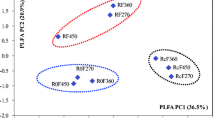Abstract
Intercropping legumes with cereals for forage production is a sustainable technique showing several environmental benefits. We studied yields, quality and the growth rate of a 2-year experiment including (1) sole crops of common vetch, barley and winter wheat, and (2) intercrops of common vetch with barley and winter wheat using seeding ratios of 55:45 and 65:35. Our results show that the greatest dry matter yields were obtained with wheat and barley sole crops. The lowest yield was obtained with common vetch sole crop. The intercrops produced about 13–30% more dry matter than the common vetch sole crop, but 12–23% less than cereal sole crops. Further, the growth rate of common vetch and cereals was greater when species were grown as sole crops than in intercrops. Quality components indicated an advantage for the sole crop of common vetch followed by its intercrop with barley at the 65:35 seeding ratio, which exhibited higher crude protein yield than the sole crop of cereals and the other intercrops. The results of this study indicate that common vetch intercrops with barley or winter wheat produced higher dry matter than common vetch sole crop. In addition, the intercrop of common vetch with barley (65:35) provided higher forage quality than the other intercrops. Our study highlights that vetch-cereal intercropping can be used as an alternative cropping system which combines sustainability due to N fixation from common vetch, and high yield and forage quality.
Similar content being viewed by others
References
Anil L., Park J., Phipps R.H., Miller F.A. (1998) Temperate intercropping of cereals for forage: a review of the potential for growth and utilization with particular reference to the UK, Grass Forage Sci. 53, 301–317.
Assefa G., Ledin I. (2001) Effect of variety, soil type and fertilizer on the establishment, growth, forage yield, quality and voluntary intake by cattle of oats and vetches cultivated in sole crops and mixtures, Anim. Feed Sci. Tech. 92, 95–111.
Association of Official Analytical Chemists (AOAC) (1980) Official Methods of Analysis, 11th ed., AOAC, Washington, DC.
Avci M., Akar T. (2006) Ecological production of dryland hairy vetch by mechanical control, Agron. Sustain. Dev. 26, 29–34.
Buxton C.L., Fales S.L. (1993) Plant environment and quality, in: Fahey G.C. Jr et al. (Eds.), Forage quality, evaluation and utilization. ASA, CSSA and SSSA Publishing, Madison, WI, USA, pp. 92–116.
Caballero R., Goicoechea E.L., Hernaiz P.J. (1995) Forage yields and quality of common vetch and oat sown at varying seeding ratios and seeding rates of common vetch, Field Crop. Res. 41, 135–140.
Carpita N., McCann M. (2000) The Cell Wall, in: Buchanan B.B., Gruissem W., Jones R.L. (Eds.), Biochemistry and Molecular Biology of Plants, American Society of Plant Biologists, Maryland, USA, pp. 52–108.
Chen C., Westcott M., Neill K., Wichman D., Knox M. (2004) Row configuration and nitrogen application for barley-pea intercropping in Montana, Agron. J. 96, 1730–1738.
Clergue B., Amiaud B., Pervanchon F., Lasserre-Joulin F., Plantureux S. (2005) Biodiversity: function and assessment in agricultural areas, A review, Agron. Sustain. Dev. 25, 1–15.
Dhima K.V., Eleftherohorinos I.G. (2001) Influence of nitrogen on competition between winter cereals and sterile oat, Weed Sci. 49, 77–82.
Goering H.K., Van Soest P.J. (1970) Forage fiber analysis: Apparatus Reagents, Procedures, and Some Applications, Agric. Handbook 379. U.S. Gov. Print. Office, Washington DC, USA, pp. 3979–3991.
Haj-Ayed M., Gonzalez J., Caballero R., Alvir M.R. (2000) Nutritive value of on-farm common vetch-oat hays. II. Ruminal degradation of dry matter and crude protein, Ann. Zootech. 49, 391–398.
Horrocks R.D., Vallentine J.F. (1999) Harvested forages, Academic Press, London, UK, pp. 17–47.
Jannink J.-L., Leibman M., Merrick L.C. (1996) Biomass production and nitrogen accumulation in pea, oat, and vetch green manure mixtures, Agron. J. 88, 231–240.
Lauriault L.M., Kirksey R.E. (2004) Yield and nutritive value of irrigated winter cereal forage grass-legume intercrops in the southern high plain, USA, Agron. J. 96, 352–358.
Lithourgidis A.S., Vasilakoglou I.B., Dhima K.V., Dordas C.A., Yiakoulaki M.D. (2006) Forage yield and quality of common vetch mixtures with oat and triticale in two seeding ratios, Field Crop. Res. 99, 106–113.
Mead R., Willey R.W. (1980) The concept of a land equivalent ratio and advantages in yields for intercropping, Exp. Agr. 16, 217–228.
Osman A.E., Nersoyan N. (1986) Effect of the proportion of species on the yield and quality of forage mixtures, and on the yield of barley in the following year, Exp. Agr. 22, 345–351.
Qamar I.A., Keatinge J.D.H., Mohammad N., Ali A., Khan M.A. (1999) Introduction and management of common vetch/barley forage mixtures in the rainfed areas of Pakistan. 3. Residual effects on following cereal crops, Aust. J. Agr. Res. 50, 21–27.
Roberts C.A., Moore K.J., Johnson K.D. (1989) Forage quality and yield of wheat-common vetch at different stages of maturity and common vetch seeding rate, Agron. J. 81, 57–60.
Rodrigo V.H., Stirling C.M., Teklehaimanot Z., Samarasekera R.K., Pathirana P.D. (2005) Interplanting banana at high densities with immature rubber crop for improved water use, Agron. Sustain. Dev. 25, 45–54.
Stern W.R. (1993) Nitrogen fixation and transfer in intercrop systems, Field Crop. Res. 34, 335–356.
Thompson D.J., Stout D.G., Moore T. (1992) Forage production by four annual cropping sequences emphasizing barley irrigation in southern interior British Columbia, Can. J. Plant Sci. 72, 181–185.
Thomson E.F., Rihawi S., Nersoyan N. (1990) Nutritive value and yields of some forage legumes and barley harvested as immature herbage, hay and straw in North-West Syria, Exp. Agr. 26, 49–56.
Vandermeer J.H. (1990) Intercropping. Agroecology, McGraw-Hill Publishing, New York, USA, pp. 481–516.
Velazquez-Beltran L.G., Felipe-Perez Y.E., Arriaga-Jordan C.M. (2002) Common vetch (Vicia sativa) for improving the nutrition of working equids in campesino systems on hill slopes in central Mexico, Trop. Anim. Health Pro. 34, 169–179.
Author information
Authors and Affiliations
Corresponding author
About this article
Cite this article
Lithourgidis, A.S., Dhima, K.V., Vasilakoglou, I.B. et al. Sustainable production of barley and wheat by intercropping common vetch. Agron. Sustain. Dev. 27, 95–99 (2007). https://doi.org/10.1051/agro:2006033
Accepted:
Issue Date:
DOI: https://doi.org/10.1051/agro:2006033




